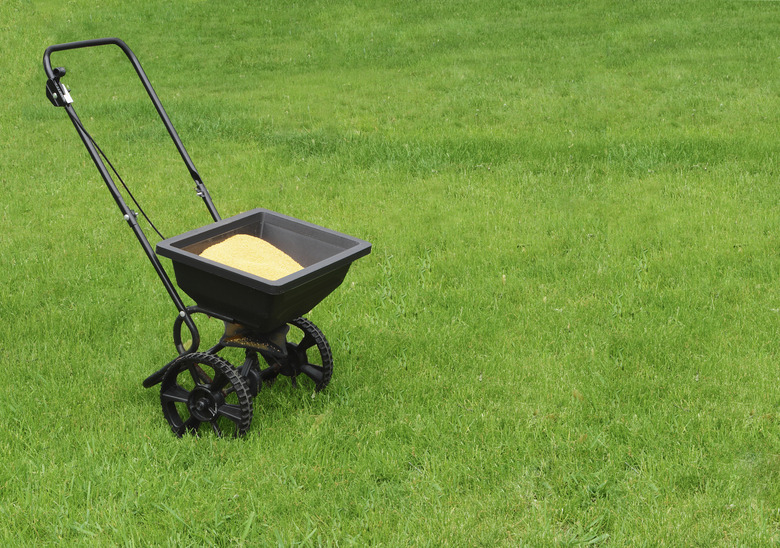List Of Fertilizer Spreader Settings
Generic spreader settings only work well as a guide because of the differences between manufacturers. Taking the time to put together your own list of spreader settings ensures even and correct coverage when you apply fertilizers, seed, or granular herbicides and pesticides to your lawn. Wear gloves and long sleeves, and avoid testing near pets and children, when creating a setting list for chemical fertilizers and herbicides.
Spreader Types
Calibration and fertilizer settings vary depending on the type of spreader. Drop spreaders use a gravity-fed system that drops the contents evenly between the two spreader wheels. You must make each pass so there are no gaps in the spreader rows to ensure even coverage. Rotary spreaders have a flywheel that flings the contents out beyond the spreader wheels, so gaps between spreader rows are not a major issue, although you must overlap the coverage area to provide a consistent application. Setting rotary spreaders is more difficult because of the more uneven spreading pattern.
Drop Spreader Callibration
Initial calibration begins with marking off a testing area that will equal 100 square feet when multiplied by the width of the spreader's drop zone. For example, a 50-square-foot testing area is required for a 2-foot-wide spreader. Cover the area with a tarp and mark the start and finish line on the tarp with masking tape. Fill the spreader with the amount of fertilizer or seed necessary to cover your lawn, and then push it along the marked course. Open the hopper as you cross the start line and close it as soon as you reach the finish line. To check each setting, begin with the lowest setting and increase the setting at each pass. After each pass, sweep up and weigh the materials to determine how much each setting applies per 100 square feet. Multiply the amount by 10 to determine the amount of material applied per 1,000 square feet.
Calibrating Rotary Spreaders
Determination of the application width is necessary before you can calibrate a rotary spreader. Prepare a tarp for testing and fill the spreader half-full. Make one pass with the spreader on the medium setting, and then measure the width of the applied materials. The amount of material applied decreases as you move away from the central pass, so decrease the width measurement by two-thirds to determine spreader width. Mark out your testing course to a length that equals 1,000 square feet when multiplied by the effective spreader width, and then run the spreader over the test course. Sweep up and weigh the materials to determine the application rate for each spreader setting.
Application Amounts and Settings
Simple materials like seeds and herbicides generally come with a setting guide on the bag, such as an application of 5 pounds per 1,000 square feet. Select the setting that most closely matches the necessary application rate from your calibration list and notes. Fertilizer application recommendations depend on the type of fertilizer and whether you are fertilizing lawn or garden, with the recommendations listed on the bag. For example, 1 pound of nitrogen is typically necessary per 1,000 square feet of lawn. If you divide 100 by the percentage of nitrogen in the fertilizer, which is the first number in the analysis listing, you can determine the pounds of nitrogen in the bag. For example, 16-4-8 fertilizer requires 6.25 pounds to cover 1,000 square feet. Choose the calibrated setting on the spreader that is closest to the 6.25-pound application rate.
